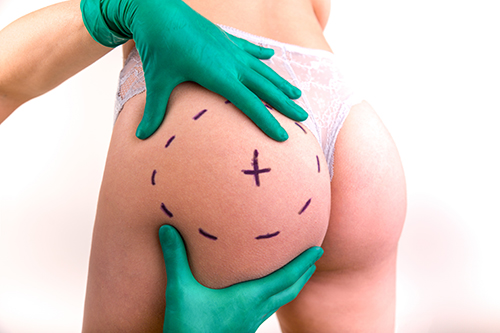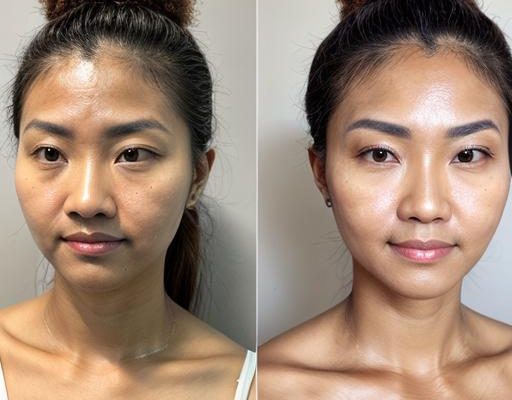A liquid facelift is a non-surgical cosmetic procedure that uses injectable fillers to restore volume, smooth wrinkles and contour the face. It is a popular alternative to traditional surgical facelifts and offers natural-looking results.
The procedure involves the injection of dermal fillers such as hyaluronic acid into specific areas of the face to achieve the desired results. The fillers work by plumping the skin, filling in wrinkles and lines, as well as stimulating the production of collagen, which helps to improve skin elasticity and firmness.
A liquid facelift can be used to address a variety of concerns, including
- Fine lines and wrinkles
- sunken cheeks
- Empty eyes
- Nasolabial folds (smile lines)
- Marionette lines (lines extending from the corners of the mouth to the chin)
The procedure can take between 30 minutes to an hour to complete. Patients may experience swelling, bruising or redness in the treated areas. However, these side effects usually subside within a few days.
A liquid facelift is a safe and effective way to achieve a more youthful and refreshed appearance without the risks and downtime associated with traditional surgical facelifts. However, it is very important to choose a qualified and experienced specialist to achieve the best possible results.

Benefits of a Liquid Facelift
Minimally Invasive
Unlike traditional facelift surgery, a liquid facelift is minimally invasive and does not require any incisions or general anesthesia.
Natural Looking Results
One of the most important benefits of a liquid facelift is that it can provide natural-looking results. The procedure incorporates dermal fillers and neuromodulators that can help restore volume and smooth wrinkles without making the face look exaggerated or unnatural.
Customizable
Another advantage of a liquid facelift is that it is highly customizable. A skilled specialist can tailor the treatment to meet the specific needs and goals of each patient. This means that individuals can achieve a more personalized and targeted approach to facial rejuvenation.
Fast and Convenient
A liquid facelift is a quick and convenient procedure that can be completed in as little as 30 minutes. Patients can usually return to their normal activities immediately after treatment, making it an ideal option for those with busy schedules.
Cost Effective
Compared to traditional facelift surgery, a liquid facelift is generally more cost-effective.
Liquid Facelift Procedure
- Consultation: The first step of the procedure is a consultation with the medical specialist. The patient’s medical history, expectations and desired results are discussed during this consultation. The specialist will also examine the patient’s face and recommend the best approach to achieve the desired result.
- Preparation: Once the treatment plan has been agreed upon, the medical specialist will prepare the patient for the procedure. This may include cleansing the face and applying a numbing cream to minimize discomfort during the injections.
- Injections: The specialist will inject the filler into the targeted areas of the face using a fine needle. The number of injections and the filler used will depend on the needs of the patient and the desired result.
- Post-treatment: Once the injections are complete, the patient is given post-treatment instructions. These may include avoiding certain activities and products for a period of time and applying ice to reduce swelling and bruising.
Types of Fillers Used
Hyaluronic Acid Fillers
Hyaluronic acid fillers are the most commonly used fillers in liquid facelifts. They are made from a substance found naturally in the body. Hyaluronic acid fillers can be used to treat various areas of the face, including the cheeks, lips and nasolabial folds. They are also used to add volume to the face and reduce the appearance of wrinkles.
Popular hyaluronic acid fillers are:
- Juvederm
- Restylane
- Belotero
Poly-L-Lactic Acid Fillers
Poly-L-Lactic acid fillers are another type of filler used for liquid facelifts. They are made from a synthetic substance that stimulates collagen production in the skin. This helps to add volume to the face and reduce the appearance of wrinkles.
Poly-L-Lactic acid fillers are typically used to treat larger areas of the face, such as the cheeks and temples. They are also used to treat deep wrinkles and folds.
The most well-known Poly-L-Lactic acid filler is Sculptra.
Calcium Hydroxylapatite Fillers
Calcium hydroxylapatite fillers are a type of filler made from a substance found naturally in bones. Calcium hydroxylapatite fillers are typically used to treat deeper wrinkles and facial folds.
An example of the most popular Calcium Hydroxylapatite fillers is Radiesse.
Aftercare
After a liquid facelift, it is important to properly care for the treated area to achieve the best results. Below are some general post-procedure care guidelines:
Avoid touching or rubbing the treated area
Patients should avoid touching or rubbing the treated area for at least 24 hours after the procedure. This will help prevent any irritation or infection. Patients should also avoid applying makeup or skin care products to the treated area for at least 24 hours.
Apply ice packs
To reduce swelling and bruising, patients can apply ice packs to the treated area several times a day for 10-15 minutes at a time for the first few days after the procedure.
Avoid strenuous physical activity.
Patients should avoid strenuous physical activity for at least 24 hours after the procedure. This includes exercise, heavy lifting and any activity that increases blood flow to the face.
Sleep with your head elevated.
Patients should sleep with their head elevated for the first few nights after the procedure. This will help reduce swelling and bruising.
Risks and Complications
As with any cosmetic procedure, a liquid facelift has potential risks and complications that patients should be aware of. While the odds are generally low, it is very important to understand what they are and how they can be mitigated.
Bruising and Swelling
One of the most common side effects is bruising and swelling. This is to be expected and usually resolves within a few days to a week. Patients can minimize bruising and swelling by avoiding blood-thinning medications and supplements such as aspirin and fish oil for at least a week before the procedure.
Infection
Although rare, infection is a potential complication of any injectable procedure. Patients can reduce their risk of infection by choosing a reputable specialist and following proper aftercare instructions, such as keeping injection sites clean and avoiding touching the site.
Allergic Reaction
Some patients may be allergic to the ingredients in the injectable fillers used during a liquid facelift. It is important to discuss any allergies or sensitivities with the provider before the procedure. If an allergic reaction occurs, it can typically be treated with antihistamines or steroids.
Nerve Damage
In rare cases, the injection of filler during the procedure can cause nerve damage. This can result in numbness, tingling or even paralysis in the affected area. Patients can reduce the risk of nerve damage by choosing a specialist with experience and skill in performing the procedure.
Permanence of Liquid Face Lift
The longevity of a liquid facelift depends largely on the type of filler used and the person’s body chemistry.
Typically, the results of a liquid facelift can last anywhere from six months to two years.
Hyaluronic acid fillers such as Juvederm and Restylane are some of the most popular fillers used in liquid facelifts. These fillers can last anywhere from six to eighteen months, depending on the specific product used and the area of the face being treated.
Calcium hydroxylapatite fillers such as Radiesse can last up to two years. This type of filler can stimulate collagen production, providing longer-lasting results.
Polylactic acid fillers such as Sculptra can also last up to two years. This filler works by stimulating collagen production and can continue to improve the appearance of the face even after the body absorbs the filler.
Although the results of a liquid facelift last for a significant period of time, it is important to remember that they are not permanent. Touch-up treatments will be necessary to maintain the desired results.



